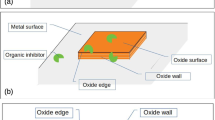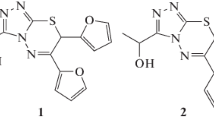Abstract
The adsorption and passivation reactions of 5-methyl benzotriazole (MBTA) with different copper samples (as received, citric acid treated and citric acid and KIO4 treated) were studied. The experiments were characterized by contact angle measurement, potentiodynamic polarization curve, electrochemical impedance spectroscopy and X-ray photoelectron spectroscopy. The results showed that the adsorption behavior of MBTA on different treated surfaces was different and MBTA was preferentially adsorbed on the surface of citric acid treated copper. Based on the density functional theory, quantum chemical descriptors such as the frontier molecular orbital energies EHOMO, ELUMO and the energy gap between them, molecular electrostatic potential, and Fukui function had been calculated and discussed. The adsorption mechanism of MBTA and copper surface was further revealed, which had positive significance for the corrosion inhibition of copper surface in copper interconnection CMP.
Graphic Abstract













Similar content being viewed by others
References
Wang, Q., Tan, B.M., Gao, B.H., et al.: Study on the adsorption and inhibition mechanism of 1,2,4-triazole on copper surface in copper interconnection CMP. ECS J. Solid State Sci. Technol. 8, P313–P318 (2019). https://doi.org/10.1149/2.0121906jss
Zhan, D.P., Han, L.H., Zhang, J., et al.: Electrochemical micro/nano-machining: principles and practices. Chem. Soc. Rev. 46, 1526–1544 (2017). https://doi.org/10.1039/c6cs00735j
Mohammad, A.E.K., Wang, D.: Electrochemical mechanical polishing technology: recent developments and future research and industrial needs. Int. J. Adv. Manuf. 86, 1909–1924 (2016). https://doi.org/10.1007/s00170-015-8119-6
Yadav, K., Bisen, J.C., Victoria, S.N., et al.: Sodium hypochlorite as an oxidizing agent in silica based ruthenium chemical mechanical planarization slurry. Microelectron. Eng. 180, 96–100 (2017). https://doi.org/10.1016/j.mee.2017.06.006
Jiang, L., He, Y.Y., Li, Y.Z., et al.: Effect of ionic strength on ruthenium CMP in H2O2-based slurries. Appl. Surf. Sci. 317, 332–337 (2014). https://doi.org/10.1016/j.apsusc.2014.08.063
Gao, B.H., Tan, B.M., Liu, Y.L., et al.: A study of FTIR and XPS analysis of alkaline-based cleaning agent for removing Cu-BTA residue on Cu wafer. Surface Interface Anal. 51, 566–575 (2019). https://doi.org/10.1002/sia.6623
Zhou, J.K., Niu, X.H., Cui, Y.Q., et al.: Study on the film forming mechanism, corrosion inhibition effect and synergistic action of two different inhibitors on copper surface chemical mechanical polishing for GLSI. Appl. Surf. Sci. 505, 1–13 (2020). https://doi.org/10.1016/j.apsusc.2019.144507
Yin, D., Yang, L., Niu, X.H., et al.: Theoretical and electrochemical analysis on inhibition effect of benzotriazole and 1,2,4-triazole on cobalt surface. Colloids Surf. A 591, 1–11 (2020). https://doi.org/10.1016/j.colsurfa.2020.124516
Guo, L., Obot, I.B., Zheng, X.W., et al.: Theoretical insight into an empirical rule about organic corrosion inhibitors containing nitrogen, oxygen, and sulfur atoms. Appl. Surf. Sci. 406, 301–306 (2017). https://doi.org/10.1016/j.apsusc.2017.02.134
Guo, L., El-Bakri, Y., Anouar, E.H., et al.: Multidimensional insights involving electrochemical and in silico investigation into the corrosion inhibition of newly synthesized pyrazolotriazole derivatives on carbon steel in a HCl solution. RSC Adv. 9, 34761–34771 (2019). https://doi.org/10.1039/c9ra05881h
Guo, L., Tan, J.H., Kaya, S., et al.: Multidimensional insights into the corrosion inhibition of 3,3-dithiodipropionic acid on Q235 steel in H2SO4 medium: a combined experimental and in silico investigation. J. Colloid Interface Sci. 570, 116–124 (2020). https://doi.org/10.1016/j.jcis.2020.03.001
Yan, C.Q., Liu, Y.L., Zhang, J., et al.: Synergistic effect of glycine and BTA on step height reduction efficiency after copper CMP in weakly alkaline slurry. ECS J. Solid State Sci. Technol. 6, P1–P6 (2017). https://doi.org/10.1149/2.0291612jss
Cho, B.J., Kim, J.Y., Hamada, S., et al.: Effect of pH and chemical mechanical planarization process conditions on the copper–benzotriazole complex formation. Chem. Phys. Lett. 55, 1–5 (2016). https://doi.org/10.7567/jjap.55.06jb01
Manivannan, R., Cho, B.J., Hailin, X., et al.: Characterization of non-amine-based post-copper chemical mechanical planarization cleaning solution. Microelectron. Eng. 122, 33–39 (2014). https://doi.org/10.1016/j.mee.2014.02.034
Miao, Y.X., Wang, S.L., Wang, C.W., et al.: Effect of chelating agent on benzotriazole removal during post copper chemical mechanical polishing cleaning. Microelectron. Eng. 130, 18–23 (2014). https://doi.org/10.1016/j.mee.2014.08.012
Ryu, H.Y., Cho, B.J., Yerriboina, N.P., et al.: Selection and optimization of corrosion inhibitors for improved Cu CMP and post-Cu CMP Cleaning. ECS J. Solid State Sci. Technol. 8, 3058–3062 (2019). https://doi.org/10.1149/2.0101905jss
Cho, B.J., Shima, S., Hamada, S., et al.: Investigation of Cu-BTA complex formation during Cu chemical mechanical planarization process. Appl. Surf. Sci. 384, 505–510 (2016). https://doi.org/10.1016/j.apsusc.2016.05.106
L. Jiang, Y. Y. He, X. C. Lu, et al. Investigation on the galvanic corrosion of copper during chemical mechanical polishing of ruthenium barrier layer. [C]//International Conference on Planarization/CMP Technology, Kobe, (2014) pp. 209–216. https://doi.org/10.1109/icpt.2014.7017282
Cheng, J., Wang, T.Q., Lu, X.C.: Galvanic corrosion inhibitors for Cu/Ru Couple during chemical mechanical polishing of Ru. ECS J. Solid State Sci. Technol. 6, 62–67 (2017). https://doi.org/10.1149/2.0181701jss
Jiang, L., He, Y.Y., Niu, X.Y., et al.: Synergetic effect of benzotriazole and non-ionic surfactant on copper chemical mechanical polishing in KIO4-based slurries. Thin Solid Films 558, 272–278 (2014). https://doi.org/10.1016/j.tsf.2014.01.086
Cheng, J., Pan, J.S., Wang, T.Q., et al.: Micro-galvanic corrosion of Cu/Ru couple in potassium periodate (KIO4) solution. Corros. Sci. 137, 184–193 (2018). https://doi.org/10.1016/j.corsci.2018.03.045
Turk, M.C., Shi, X., Gonyer, D.A.J., et al.: Chemical and mechanical aspects of a Co-Cu planarization scheme based on an alkaline slurry formulation. ECS J. Solid State Sci. Technol. 5, P88–P99 (2016). https://doi.org/10.1149/2.0271602jss
Lu, F.Y., Song, B.D., He, P., et al.: Electrochemical impedance spectroscopy (EIS) study on the degradation of acrylic polyurethane coatings. RSC Adv. 7, 13742–13748 (2017). https://doi.org/10.1039/c6ra26341k
Yuan, X.Z., Wang, H.J., Sun, J.C., et al.: AC impedance technique in PEM fuel cell diagnosis—A review. Int. J. Hydrogen Energy 32, 4365–4380 (2007). https://doi.org/10.1016/j.ijhydene.2007.05.036
Tian, S.Y., Tan, B.M., Gao, B.H., et al.: Effects of novel inhibitor on galvanic corrosion of copper and cobalt and particle removal. ECS J. Solid State Sci. Technol. 8, 545–552 (2019). https://doi.org/10.1149/2.0201909jss
Sherwood, P.M.: X-ray photoelectron spectroscopic studies of some iodine compounds. J. Chem. Soc. Farad. Trans. 2: Mol. Chem. Phys. 72, 1805–1820 (1976). https://doi.org/10.1039/f29767201805
Guo, L., Safi, Z.S., Kaya, S., et al.: Anticorrosive effects of some thiophene derivatives against the corrosion of iron: a computational study. Front. Chem. 6, 1–12 (2018). https://doi.org/10.3389/fchem.2018.00155
Dagdag, O., El Harf, A., Cherkaoui, O., et al.: Rheological, electrochemical, surface, DFT and molecular dynamics simulation studies on the anticorrosive properties of new epoxy monomer compound for steel in 1 M HCl solution. RSC Adv. 9, 4454–4462 (2019). https://doi.org/10.1039/c8ra09446b
Krishna-Priya, M., Revathi, B.K., Renuka, V., et al.: Molecular structure, spectroscopic (FT-IR, FT-Raman, 13C and 1H NMR) analysis, HOMO-LUMO energies, Mulliken, MEP and thermal properties of new chalcone derivative by DFT calculation. Sci. Direct 8, 37–46 (2019). https://doi.org/10.1016/j.matpr.2019.02.078
Uzun, Serap, Esen, Zeynep, Koç, Esra, et al.: Experimental and density functional theory (MEP, FMO, NLO, Fukui functions) and antibacterial activity studies on 2-amino-4-(4-nitrophenyl)-5,6-dihydrobenzo [h] quinoline-3-carbonitrile. J. Mol. Struct. 1178, 450–457 (2019). https://doi.org/10.1016/j.molstruc.2018.10.001
Scrocco, E., Tomasi, J.: Electronic molecular structure, reactivity and intermolecular forces: an euristic interpretation by means of electrostatic molecular potentials. Adv. Quantum Chem. 11, 115–193 (1978). https://doi.org/10.1016/S0065-3276(08)60236-1
Tan, Bochuan, Zhang, Shengtao, Liu, Hongyan, et al.: Insights into the inhibition mechanism of three 5-phenyltetrazole derivatives for copper corrosion in sulfuric acid medium via experimental and DFT methods. J. Taiwan Inst. Chem. Eng. 102, 424–437 (2019). https://doi.org/10.1016/j.jtice.2019.06.005
Lesar, A., Milošev, I.: Density functional study of the corrosion inhibition properties of 1,2,4- triazole and its amino derivatives. Chem. Phys. Lett. 483, 198–203 (2009). https://doi.org/10.1016/j.cplett.2009.10.082
Acknowledgements
This work was supported by the Major National Science and Technology Special Projects (No. 2016ZX02301003-004-007), the Natural Science Foundation, China (No. 61704046), and the Hebei Natural Science Foundation Project (No. F2018202174). The authors thank the teachers and classmates for helpful discussions.
Author information
Authors and Affiliations
Corresponding authors
Additional information
Publisher's Note
Springer Nature remains neutral with regard to jurisdictional claims in published maps and institutional affiliations.
Rights and permissions
About this article
Cite this article
Liu, M., Yin, D., Tan, B. et al. Toward Understanding the Adsorption And Inhibition Mechanism of Cu-MBTA Passivation Film on Copper Surface: A Combined Experimental and DFT Investigation. Electron. Mater. Lett. 17, 109–118 (2021). https://doi.org/10.1007/s13391-020-00255-8
Received:
Accepted:
Published:
Issue Date:
DOI: https://doi.org/10.1007/s13391-020-00255-8




